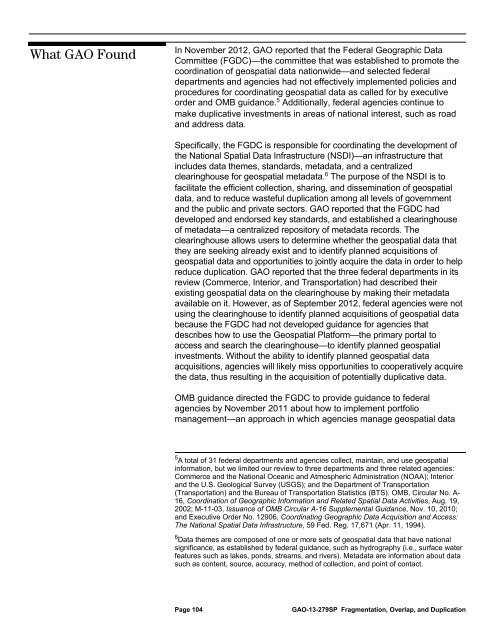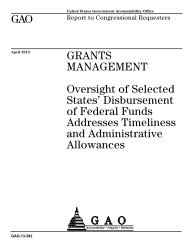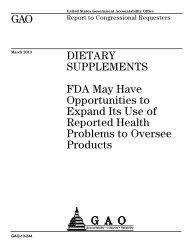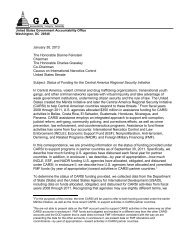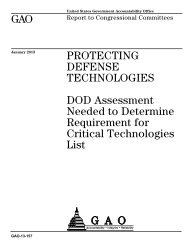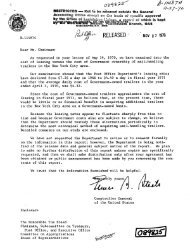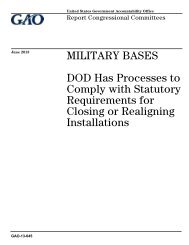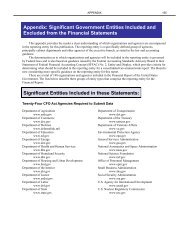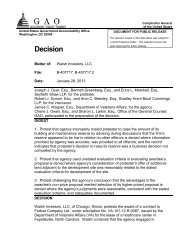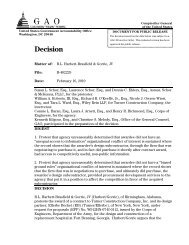GAO-13-279SP, 2013 Annual Report - US Government ...
GAO-13-279SP, 2013 Annual Report - US Government ...
GAO-13-279SP, 2013 Annual Report - US Government ...
You also want an ePaper? Increase the reach of your titles
YUMPU automatically turns print PDFs into web optimized ePapers that Google loves.
What <strong>GAO</strong> Found<br />
In November 2012, <strong>GAO</strong> reported that the Federal Geographic Data<br />
Committee (FGDC)—the committee that was established to promote the<br />
coordination of geospatial data nationwide—and selected federal<br />
departments and agencies had not effectively implemented policies and<br />
procedures for coordinating geospatial data as called for by executive<br />
order and OMB guidance. 5 Additionally, federal agencies continue to<br />
make duplicative investments in areas of national interest, such as road<br />
and address data.<br />
Specifically, the FGDC is responsible for coordinating the development of<br />
the National Spatial Data Infrastructure (NSDI)—an infrastructure that<br />
includes data themes, standards, metadata, and a centralized<br />
clearinghouse for geospatial metadata. 6 The purpose of the NSDI is to<br />
facilitate the efficient collection, sharing, and dissemination of geospatial<br />
data, and to reduce wasteful duplication among all levels of government<br />
and the public and private sectors. <strong>GAO</strong> reported that the FGDC had<br />
developed and endorsed key standards, and established a clearinghouse<br />
of metadata—a centralized repository of metadata records. The<br />
clearinghouse allows users to determine whether the geospatial data that<br />
they are seeking already exist and to identify planned acquisitions of<br />
geospatial data and opportunities to jointly acquire the data in order to help<br />
reduce duplication. <strong>GAO</strong> reported that the three federal departments in its<br />
review (Commerce, Interior, and Transportation) had described their<br />
existing geospatial data on the clearinghouse by making their metadata<br />
available on it. However, as of September 2012, federal agencies were not<br />
using the clearinghouse to identify planned acquisitions of geospatial data<br />
because the FGDC had not developed guidance for agencies that<br />
describes how to use the Geospatial Platform—the primary portal to<br />
access and search the clearinghouse—to identify planned geospatial<br />
investments. Without the ability to identify planned geospatial data<br />
acquisitions, agencies will likely miss opportunities to cooperatively acquire<br />
the data, thus resulting in the acquisition of potentially duplicative data.<br />
OMB guidance directed the FGDC to provide guidance to federal<br />
agencies by November 2011 about how to implement portfolio<br />
management—an approach in which agencies manage geospatial data<br />
5 A total of 31 federal departments and agencies collect, maintain, and use geospatial<br />
information, but we limited our review to three departments and three related agencies:<br />
Commerce and the National Oceanic and Atmospheric Administration (NOAA); Interior<br />
and the U.S. Geological Survey (<strong>US</strong>GS); and the Department of Transportation<br />
(Transportation) and the Bureau of Transportation Statistics (BTS). OMB, Circular No. A-<br />
16, Coordination of Geographic Information and Related Spatial Data Activities, Aug. 19,<br />
2002; M-11-03, Issuance of OMB Circular A-16 Supplemental Guidance, Nov. 10, 2010;<br />
and Executive Order No. 12906, Coordinating Geographic Data Acquisition and Access:<br />
The National Spatial Data Infrastructure, 59 Fed. Reg. 17,671 (Apr. 11, 1994).<br />
6 Data themes are composed of one or more sets of geospatial data that have national<br />
significance, as established by federal guidance, such as hydrography (i.e., surface water<br />
features such as lakes, ponds, streams, and rivers). Metadata are information about data<br />
such as content, source, accuracy, method of collection, and point of contact.<br />
Page 104<br />
<strong>GAO</strong>-<strong>13</strong>-<strong>279SP</strong> Fragmentation, Overlap, and Duplication


